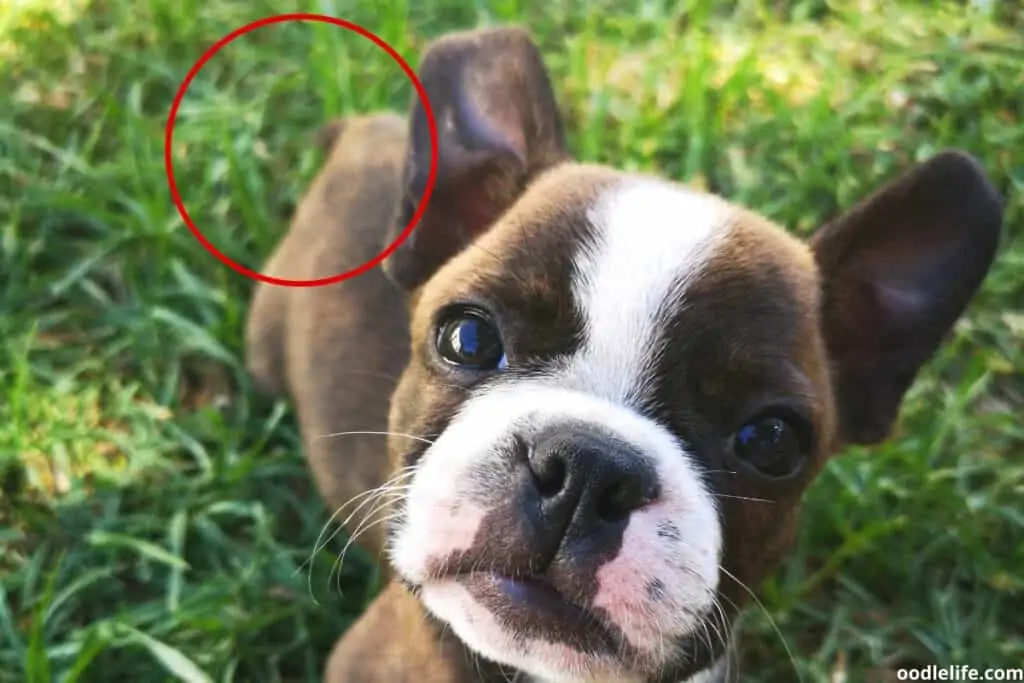Do Boston Terriers Have Tails? [Photos]
It’s easy to overlook a dog breed’s physical trait until you see a dog from the same breed that looks different than what you usually see. In the case of Boston Terriers, this often has to do with their tail.
So, do Boston Terriers have tails?

Yes, Boston Terriers have tails.
However, the length can vary from a stub that barely looks like a tail to a longer, downward-facing tail. Furthermore, a Boston Terrier’s tail shape varies.
I’ll help you understand the many types of Boston Terrier tail styles, why some people value their tail characteristics so much, and the health consequences that certain tail types can generate.
Characteristics of a Boston Terrier’s Tail

The question “Do Boston Terriers have tails?” is nuanced, given that their tails come in many shapes and sizes. However, the Kennel Club recognizes Boston Terriers as a short-tail breed. Their tail is also low-lying.
However, the Boston Terrier’s tail appearance can vary significantly, from barely a stub to something resembling a portion of a long tail.
Below are the most common Boston Terrier tail styles.
Screwed Tail
The screwed tail style, which you’ll also hear some people calling a curled tail, is the most recognized type of Boston Terrier tail. It only grows one to two inches long, and although it looks cute, it requires special care.
That’s because screwed tails have a high rate of infection. Because of its curly nature, it can get in the way of your dog’s excretions. As a result, it’s crucial to keep your Boston Terrier’s bottom cleaned by using dog-approved wipes. In the case of an infection, you’ll need to use medicated wipes.
Bobbed Tail
If before now you believed that Boston Terriers didn’t have a tail at all, it’s because you were looking at a dog with a bobbed tail. The bobbed tail appearance is the American Kennel Club’s standard tail type for Boston Terriers. It looks like a little cotton ball stub where a tail normally grows.
Bobbed tails are naturally occurring in Boston Terriers, and they result from the mutated T-box gene. Such a gene trait is the reason why many, but not all, naturally short-tailed dogs have this characteristic.
Crooked Tail
Crooked tails are a tell-tale sign that your Boston Terrier has a higher chance of developing hemivertebrae. I’ll talk more about hemivertebrae shortly, but for now, know that it’s a painful condition that can require surgery to alleviate.
You can expect crooked tails to grow two to three inches long, and it may have a lengthy but crooked appearance, especially if your Boston Terrier has hemivertebrae.
Gay Tail
Boston Terriers with gay tails get their name because their tails sit higher up than usual. As a result, any stub or tail these dogs have tends to stick up straight, making them look extra happy all the time.
If you want a Boston Terrier to take them to dog shows, you’ll need to avoid the gay tail, as it begins too high for them to qualify. Of course, most people don’t take their dogs to shows, so you can embrace your Boston Terrier’s cute gay tail that competitions frown upon.
Straight Tail
If your Boston Terrier has a straight tail, it’s a bit of a paradox—this is the healthiest tail type, but it’s also the least common in this breed.
Straight Tails point downwards and are unsurprisingly straight. The advantage of this tail arrangement for your Boston Terrier is that they can more easily wag their tails and have fewer risks of infection issues.
Long Tail
You’re among the majority if you’ve never seen a Boston Terrier with a long tail. Furthermore, Boston Terriers with long tails usually have another breed mixed with them.
Nevertheless, genetic mutations can happen that can give your purebred Boston Terrier a long tail. When this happens, some people seek to dock their dog’s tail. I’ll talk about docking shortly and strongly discourage you from taking this unnecessary recourse.
Like dogs with straight tails, Boston Terriers with long tails often enjoy fewer tail-related health issues.
The “Perfect” Boston Terrier Tail
If you want a Boston Terrier strictly as a pet and not for show, you’ll understandably argue that their tail is perfect as is.
However, the American Kennel Club (AKC) has its own rules for how a Boston’s tail must appear to prove they’re purebred. They are as follows:
- A fine, tapering tail
- Screw or straight-shaped
- Tail set on low and carried above the horizontal
- Must not exceed one-quarter long from the base of the tail to the hock
So, if your Boston Terrier doesn’t fulfill all four of these traits, the chances are high that they have mixed breeding somewhere in their genes.

The Poor Practice of Docking
Docking is the practice of shortening a dog’s natural tail length. There’s a long history of reasons people dock a dog’s tail, from ancient Romans believing it would prevent a dog from getting rabies to reducing the chance of injury in hunting dogs.
Unfortunately, docking is now most popularly done for cosmetic reasons. Although Boston Terriers naturally have short tails, some people try to get around the AKC’s policies by docking their dog’s tail so that they can qualify for competitions.
Doing so is strictly prohibited by the AKC. Furthermore, many states ban or have strict regulations around docking a dog’s tail. That’s because there’s always the risk of complications from docking, such as infection, necrosis, and excessive bleeding.
To make matters worse, some people try docking their Boston Terrier’s tails at home instead of taking them for professional surgery. They may wrap rubber bands around the dog’s tail to stop the blood flow until the tail falls or, in even crueler cases, cut off the tail.

The Boston Terrier’s Struggle with Hemivertebrae
Sadly, Boston Terriers have a higher chance than many other breeds of developing hemivertebrae, a genetic condition that causes their spine to twist. It’s a painful condition and can even affect the central nervous system.
Boston Terriers with tightly curled “screw tails” are at a higher risk of getting hemivertebrae than those without it. You’ll likely notice hemivertebrae when Boston Terriers are still puppies, as they’ll have trouble going to the bathroom and have weak hindlimbs.
A veterinarian can diagnose this problem via an x-ray and will prescribe a treatment. You may only need to give your Boston Terrier anti-inflammatory drugs in mild cases. However, moderate to severe cases of hemivertebrae require surgery to reduce the compression and your dog’s pain.
One of the best ways to choose a Boston Terrier who doesn’t have hemivertebrae is to adopt an adult dog or choose a reputable breeder who takes hemivertebrae-prone animals out of the breeding pool.

Let That Tail Wag
The next time someone asks you, “Do Boston Terriers have tails?” you’ll be able to tell them that not only do they have tails, but the length and style vary according to the dog’s genes.
Unless you plan on taking your Boston Terrier to dog shows, the shape and size of their tail shouldn’t matter much. That said, I recommend avoiding giving money to breeders who breed Boston Terriers with crooked tails because they have a higher chance of suffering from hemivertebrae.
